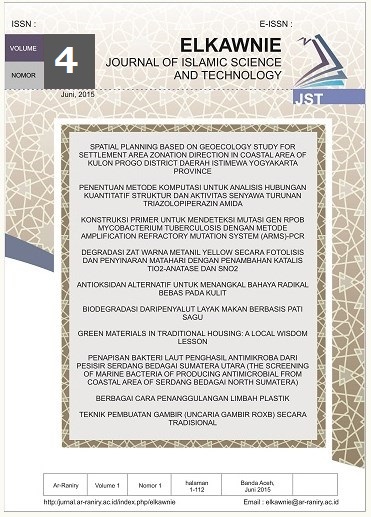Evaluasi Penerapan Safety Climate Menggunakan NOSAQ-50 Di Perusahaan Perkebunan PT. XYZ
DOI:
https://doi.org/10.22373/ekw.v4i2.3597Keywords:
Safety Climate, NOSACQ-50, Mann Whitney Test, Kruskal Wallis TestAbstract
Safety Climate merupakan persepsi bersama antara manajemen perusahaan dan pekerja dalam menangani masalah terkait dengan keselamatan kerja di dalam perusahaan. Safety Climate yang tinggi menggambarkan bahwa perusahaan sudah memiliki persepsi yang sama. Sedangkan Safety Climate yang rendah menggambarkan bahwa perusahaan masih memiliki persepsi yang berbeda. Dan perbedaan persepsi di dalam perusahaan menyebabkan terjadinya kecelakaan kerja. Karena kecelakaan kerja berawal dari perilaku tidak aman, dan perilaku tidak aman berawal dari persepsi kerja yang berbeda. Penelitian ini bertujuan untuk mengevaluasi keselamatan kerja di Perusahaan Perkebunan PT XYZ dimana setiap tahunnya masih terjadi kecelakaan kerja. Pengukuran ini dilakukan dengan menggunakan metode The Nordic Occupational Safety Climate Questionnaire (NOSACQ-50) yang terdiri dari 7 dimensi iklim kerja. Berdasarkan hasil uji Mann Whitney dan Kruskal Wallis dinyatakan tidak terdapat perbedaan signifikan Safety Climate di kelompok jabatan, jenis kelamin, umur dan lama bekerja. Sedangkan pada kelompok pendidikan terdapat perbedaan yang signifikan untuk dimensi pemberdayaan keselamatan kerja, sehingga perlu diberikan suatu usulan perbaikan iklim keselamatan untuk meningkatkan iklim keselamatan di perusahaan agar tidak terjadi lagi kecelakaan kerja di tahun beriktunya.
The safety climate is a shared perception between company management and workers in dealing with safety-related issues within the company. A high level of safety reflects that companies already have the same perception. While the low work safety climate illustrates that companies still have different perceptions. And differences in perception within the company cause work accidents. Because work accidents stem from unsafe behavior, and unsafe behavior begins with different perceptions of work. The purpose of this research is to evaluate the safety of work at Factory Plant where every year there are work accidents. This measurement is done by using The Nordic Occupational Safety Climate Questionnaire (NOSACQ-50) which consists of 7 working climate dimensions Based on test results Mann Whitney and Kruskal Wallis stated there is no significant difference in work safety climate in the occupational group, sex, age and duration of work. While in the education group there is a significant difference for the dimension of the empowerment of work safety, so it needs to be given a suggestion of improvement of the safety climate to improve the safety climate in the company in order to avoid more work accidents in the next year.
References
Buntarto. 2015. Panduan Praktis Keselamatan Dan Kesehatan Kerja Untuk Industri, Yogyakarta : PT. Pustaka Baru
Hasibuan, Chalis. 2017. Evaluasi Persepsi Safety Climate Pada Bagian Unit Gawat Darurat (UGD) di Rumah Sakit Daerah Propinsi Yogyakarta, Jurnal Rekayasa Sistem Industri 6 (2), 143-148
Carayon, Pascale. 2012. Handbook Of Human Factors and Ergonomics in Health Care and Patient Safety, London : CRC Press
Ennyra, Sheetavia. 2009. Pemetaan implementasi keselamatan kerja di enam perusahaan manufaktur Indonesia. Tugas Sarjana. Institut Teknologi Bandung.
Kines, Pete, Lappalainen, Journal, Mikkelsen, K.L, etc. 2011. Nordic Safety Climate Questionnaire (NOSACQ-50) : A new tool for diagnosing occupational safety climate. International Journal of Industrial Ergonomics, 41, 634 – 646
Neal, A & Griffin, M. A. 2002. Safety Climate and Safety Behavior. Australian Journal of Management, Volume 27. Special Issues.
Nova, Dwi. 2008. Hubungan antara persepsi karyawan terhadap iklim keselamatan (safety climate) dengan perilaku keselamatan (safety behavior). Tugas Sarjana. Universitas Islam Indonesia.
O’Toole, M. 2002. The Relationship Between Employees’ Perceptions Of Safety And Organization Culture. Journal Of Safety Research, 33, 231-234.
Downloads
Published
Issue
Section
License
Proposed Policy for Journals That Offer Open Access Authors who publish with the Elkawnie journal agree to the following terms:
a. Authors retain copyright and grant the journal right of first publication with the work simultaneously licensed under a Creative Commons Attribution License that allows others to share the work with an acknowledgement of the work's authorship and initial publication in this journal.
b. Authors are able to enter into separate, additional contractual arrangements for the non-exclusive distribution of the journal's published version of the work (e.g., post it to an institutional repository or publish it in a book), with an acknowledgement of its initial publication in this journal.
c. Authors are permitted and encouraged to post their work online (e.g., in institutional repositories or on their website) prior to and during the submission process, as it can lead to productive exchanges, as well as earlier and greater citation of published work (see The Effect of Open Access).

























